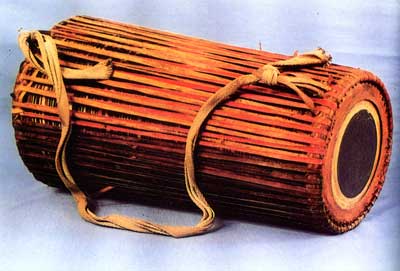
Maddal is a class of barrel shaped hand drums of the mridang class. Where other members of the mridang class tend to be used in classical music, the maddal tends to be used in folk music.
The construction of the maddal tends to be similar of the pakhawaj. As in the pakhawaj and mridangam, it invariably has a permanent application on the right hand side. However, it is really difficult to generalise about the left side application. Among the folk maddals, one may find permanent applications, dholka massala type applications, or even temporary applications such as flour and water.
One interesting characteristic of the maddal is the variety of sizes and shapes that one may find for the drum shell. Although they tend to be fairly consistent within certain geographical areas and small ethnic groups, when viewed across the breadth of South Asia one finds a very great variation.
It should be stressed that the maddal is not a single instrument but a class of related folk drums. Specific examples include the jaspura (Northeast India), madar (central India), maddale (Southwest India), and the tumdah (Northeast India). One could even argue that the pung and the khol could also be include in this classification.
Selected Video
Other Sites of Interest
Folk Drums and Tribal Girls: Sounding the Himalayas in Indian Film
Drums of India: A Pictorial Selection
The "Dḩāk", Devi Amba's Hourglass Drum in Tribal Southern Rajasthan, India
The Role of the Phariya in Tribal Acculturation in a Central Indian Market
Bower: Drums Behind the Hill (Book Review)
